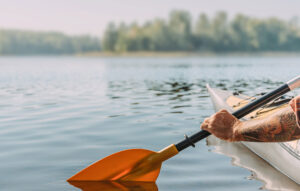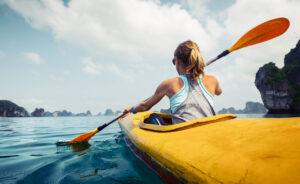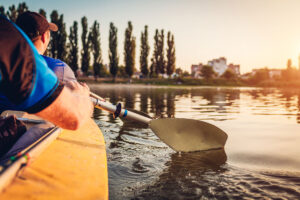
Image by Dudarev Mikhail, Shutterstock
If you’ve ever been kayaking, you know how serene it can feel to glide across a body of calm water — a lake, a pond, a gently flowing river. Also known as flatwater kayaking, kayaking in calm water offers you the freedom to explore with ease and see things you wouldn’t see from land. But just like with any kayaking adventure, paddling effectively and keeping control of your kayak is key.
For example, if you only use your arm muscles to paddle your kayak across the water and forget about your core and back muscles, your arms can get tired quickly. It’s like trying to pedal a bike with just your toes — it works, but it’s hard.
Controlling your kayak is also something that comes with practice. That control begins with learning the basics of paddling your kayak and mastering a few essential kayak strokes.
Once you learn a few fundamentals of paddling a kayak, you’ll be able to practice paddling efficiently. You’ll even reach your destination easier with less muscle fatigue. If you’re new to paddling in calm waters, these tips may be helpful for your first time out kayaking. If you’re a seasoned kayaker, you may be reminded of a few tips to use while paddling.

Image by Duet PandG, Shutterstock
1. Keep a Relaxed Grip on Your Paddle
For some people, picking up a kayak paddle and gripping it comes easy. For others, it takes practice. Remember that paddling a kayak is possible with many different grip styles, but there is one grip style that can make you more efficient and feel less fatigued when you’re paddling.
To grip your paddle, start with your large knuckles facing up while keeping a relaxed grip on the paddle. One way to start is to wrap your thumbs under the paddle, large knuckles up and lift your relaxed fingers so you have a little pressure on the paddle. Then slowly place your fingers back down keeping a gentle yet somewhat firm grip so you’re still holding the paddle enough to control your movements without the paddle slipping away.
It’s good to remember that clenching the paddle tightly makes your hands and wrists feel tired and achy, just like when you squeeze something too long. Plus, it might mess up your smooth paddling rhythm because you’re not letting your paddle move freely. By paying attention to your grip, you can make your kayaking adventure much more comfortable and enjoyable.

Image by Virrage Images, Shutterstock
2. Know Where to Place your Hands on the Paddle
When you kayak, where you place your hands on your paddle matters. And the exact placement of your hands will be unique to you and your shoulder width. To find your sweet spot, start by finding the center of your paddle and holding your paddle with a relaxed grip — placing one hand on each side of the center. Next, hold the paddle over your head and slide your hands out slowly with your elbows bent until you can make a comfy 90-degree angle. Slowly bring your arms down. That’s a good place to have your hands.
Think of this as creating a box. By creating this 90-degree angle “box” you have a good foundation to help your body twist and turn just right when you paddle. It’ll make your ride super smooth and enjoyable!
When your elbows aren’t at that nice 90-degree angle, your paddle won’t work as efficiently. It can make it harder to steer where you want to go, and you might not paddle as smoothly. Your arms and shoulders might get tired faster too, like when you’re trying to lift something heavy in an awkward way.

Image by Vitalii Nesterchuk, Shutterstock
3. Face Your Paddle Blades the Right Way
Think of your kayak paddle as a tool. The paddle has two parts at the end that look like the wings of a bird. Those are your blades. These blades can either be like twins — perfectly the same (symmetrical) — or they can be different, like having one wing shorter than the other (asymmetrical). Most likely if you’re just starting out, your blades will be symmetrical.
Depending on your paddle, the blades may have a special shape. They might curve a little or be super flat. When they’re a bit curved, they can grab the water better, just like how your hand catches a ball easily when it’s cupped.
Holding your paddle correctly involves making sure that your large knuckles point up, the shorter side of each blade is on the bottom (if applicable), and the concave (curved in) side of each blade faces you (if your blades are not flat).
When you’re getting ready for your kayaking adventure, you want to know if your paddle’s blades are symmetrical or not, and if they’re slightly curvy or super flat. This knowledge will help you paddle straight and strong in the water.

Image by Dudarev Mikhail, Shutterstock
4. Engage Your Core and Back Muscles
There are many ways to paddle a kayak. The most efficient way is using a forward stroke while engaging your core and back muscles. While you can paddle using just your arm muscles (just like you can peddle a bike with your toes), it’s more efficient to engage your core and back muscles.
Next, you’ll want to learn how to do a forward stroke with your paddle. A paddle stroke in general terms is the basic technique used by beginner kayakers to propel and steer their kayak through the water. Basically, it’s moving your paddle through the water in a way that allows you move across the top.
The forward stroke is the foundation of kayaking. To start a forward stroke, twist your torso and place one of your paddle blades fully in the water on one side of your kayak. You’ll want to start your stroke in the water about the same distance as your feet.
Next, engage your core and use your back muscles along with your arms to rotate your torso back while moving the blade slightly behind you until it reaches just behind your hip. Focusing on pushing against the paddle with your upper hand is a good tip. It’s a lot to remember, but with practice and repetition, it feels much more natural.
Finally, release your paddle blade from the water when it’s just behind your hip by bringing it out of the water straight up like slicing. If you have a near-vertical blade, you’ll be even more efficient and have a straighter and faster path through the water. Repeat this on the other side and keep practicing.

Image by Mariia Boiko, Shutterstock
5. Practice Different Paddle Techniques
Once you have your grip nailed down, you have a comfortable position for your hands on your paddle, you have your paddle blades the correct way and you learn the forward stroke and how to engage your core and back muscles, start incorporating different paddle techniques.
The reverse stroke helps you brake (or stop) your kayak and back up. A sweep stroke helps you effortlessly turn your kayak. And a draw stroke helps you move sideways.
For a reverse stroke, you wind your torso and put one of your paddle blades fully into the water on one side of your kayak next to your hip. This is sort of like the opposite of a front stroke. Then, rotate your torso as the blade moves in front of you. Then, bring the blade out of the water when it reaches your feet and repeat on the opposite side.
For a sweep stroke, you want to extend your arms forward and dip one of your blades in the water near your feet on the opposite side of your desired turn. Then sweep the blade in a wide arc toward the back of your kayak while applying power. Then finish by bringing the blade back up once it reaches a bit behind you. A good tip is to visualize the hands of a clock in the water for a wide sweep.
The draw stroke is for moving your kayak sideways. For this technique, you rotate your paddle blade horizontally and reach out with the blade tip to touch the water about two feet away directly on the side of your kayak. Then, using your lower hand, pull the blade straight towards you, keeping the blade in the water. You want to stop before the blade hits the side of the boat. Repeat as needed.
Remember, practice makes perfect. And don’t forget to enjoy the scenery along the way!
Suzanne Downing is an outdoor writer and photographer in Montana with an environmental science journalism background. Her work can be found in Outdoors Unlimited, Bugle Magazine, Missoulian, Byline Magazine, Communique, MTPR online, UM Native News, National Wildlife Federation campaigns and more.
 Your Privacy Choices
Your Privacy Choices
 The
The